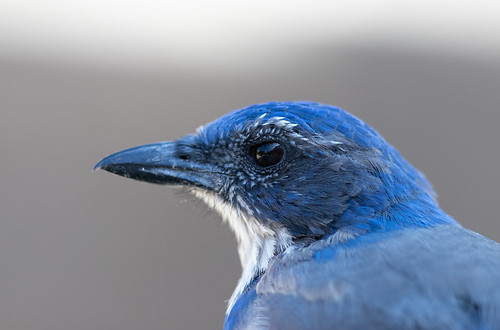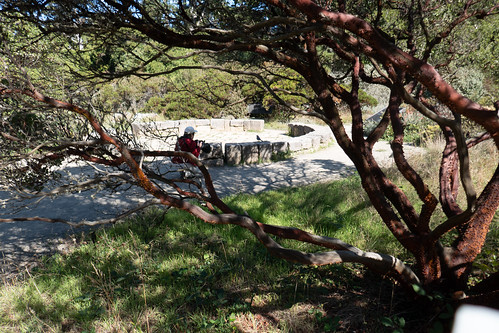I saw my very first California Scrub-Jay in May 1994, when my publisher sent me to an American Booksellers Association meeting in Los Angeles. I had a morning off, so headed to Griffith Park. I wasn’t even thinking of birds when I got my binoculars focused on a little lizard sunning in a patch of dirt, close enough that the tiny creature filled the entire view in my 10x binoculars. I was charmed, thinking how exciting it was visiting a place where such things were daily sightings, when suddenly a black triangle snapped right into the middle of the little guy. His eyes bugged out, his little legs and tongue splayed out, and that was that. I had to lower the binoculars to see what had happened—a scrub jay had grabbed the adorable lizard in its beak. This happened long before I was photographing birds, but my treasured friend Seth Bond Perry illustrated this reenactment:
I’m the kind of person who sympathizes with the eaten more than the eaters of the world, but the jay wasn’t thinking about existential questions regarding universal justice. And his sparkling eyes looking up into mine didn’t seem challenging or taunting—he simply wanted lunch.
I'd bought a sandwich on my way to Griffith Park, and when I sat down on a bench to eat it, a homeless man sat up from under some newspapers on a nearby bench, so I naturally gave him half. Voraciously, he started to scarf it down, but then a scrub jay hopped in, and that poor hungry man looked at the little bird and broke off a generous chunk of the sandwich to share. This is the world I love living in—where we look out for each other and all share what we have with our fellow creatures. My fondness for scrub jays is entwined with that encounter.
Scrub jays are among the most human of birds in terms of combining intelligence with complex social systems. We’ve learned that scrub jay individuals who are unusually sneaky and dishonest—the ones who steal food out of other scrub jay caches—are unusually suspicious, too, apparently expecting other scrub jays to be equally sneaky and dishonest. If that isn't human, what is?
We also know that when a scrub jay dies, other scrub jays join in a ritual very like a human funeral. Jennifer Ackerman, in her wonderful book, The Genius of Birds, with a gorgeous cover illustration of a scrub jay, talks about researchers at the University of California, Davis, who set a dead scrub jay in a residential neighborhood. The first scrub jay to find it made a bloodcurdling alarm call and other jays immediately flew in, the gathering getting bigger and noisier for a half hour. When the birds finally dispersed, they avoided feeding near the dead jay for a day or two.
Ackerman quoted one of my own blog entries when I wrote about watching Blue Jays at Hawk Ridge after a hawk nabbed a jay—the other jays reminded me of the Irish wake after my father, a Chicago firefighter, died. I'd written:
At the funeral home on the two nights of the wake, [my uncle], also a Chicago firefighter, met every new firefighter at the door. They’d walk up to the casket, my uncle sobbing, them talking about how good [my dad] looked except for being dead, sometimes also talking about how they should spend more time in the gym or going on a diet or something, the subtext being that they wanted to avoid the same fate. Then they’d head to the bar next door, getting back in time for my uncle to greet the next firefighter to arrive.
Hawk Ridge isn’t conveniently situated next to a bar as Chicago funeral homes all seem to be, but otherwise the jays’ behavior after one was killed always made me think of my dad’s wake. Those jay gatherings often lasted for over an hour, and if other jays were coming through while the first flock was still squawking, the new jays would join in. It’s impossible for a species with our limitations to know what their widely varied chatter and squawking meant. Were the birds feeling sorrow, anxiety, fear, or outrage? If they could calm their nerves with a good stiff drink at an Irish bar, would they? We may not understand bird language yet, but I can’t imagine that jays of all kinds don’t share a lot more in common with us humans than most people think.I'm endlessly thrilled that Jennifer Ackerman actually read my blog and quoted from it in her book, thanks to jays.
Our humanity is a tricky subject to wrap our fragile human heads and egos around. We tend to have the kind of arrogance that makes us want—even need—to believe that some wonderful thing defines us as human, setting us apart and making us essentially better than our fellow creatures. Yet any scientist who understands evolution must realize that the idea that we could be any more than incrementally different from other species is not based on science—that's where religion and non-scientific philosophy enter the scene. I was taught in Catholic school that evolution is indeed the way life on earth, including us humans, came to be. We Catholics believed that God created the system, and that at one point He stepped in and breathed into us humans a soul. But even that got murky when we started learning about St. Francis of Assisi, because our science teacher, a nun, seemed to agree with Francis that of course wolves and dogs have souls, too.
I've spent too much time in the company of dogs, cats, even gerbils, and a variety of birds to have any doubt that souls are abundant, and not restricted to humans, on this planet. What is a soul? That question is too big for me. All I know for certain is that when my eyes meet those of a jay, I see an individual being, an equal, who deserves to be reckoned with and respected.









